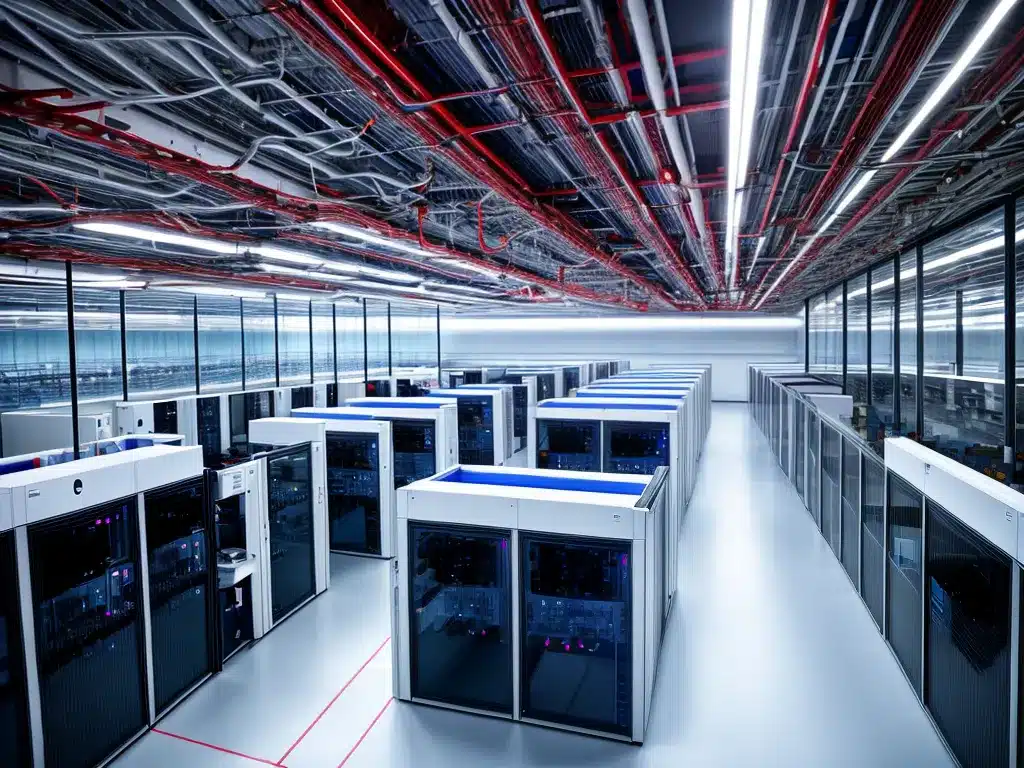
An Overview of Google’s Presence in the UK
Google has a significant presence in the United Kingdom, with large offices and data centers located across the country. I operate three major data centers in the UK, in London, Hammersmith, and St Giles. These state-of-the-art facilities house thousands of powerful servers that process search queries, store user data, and power Google’s various apps and services.
My data centers in the UK play a vital role in providing fast and reliable access to Google products for millions of users across Europe. But beyond speed and performance, these data hubs are also architectural marvels that showcase innovative cooling and green energy technologies.
In this article, I’ll give you an inside look at what happens behind closed doors. You’ll learn about the inner workings of my data centers in the UK and the advanced security protocols I’ve implemented to keep user data safe.
An Inside View of the Data Center Facilities
My data centers are top-secret facilities that few people ever get to see. But I’ll give you a peek behind the curtain.
The data centers feature rows upon rows of tall server racks containing thousands of powerful machines. The setup allows for vertical scalability and optimal airflow around each server. I use proprietary server hardware that I custom-build for speed, efficiency, and reliability.
But it’s not just servers inside. There are also:
- Electrical substations to provide power conditioning and backup diesel generators.
- Chiller plants to cool the facility.
- Air handlers to keep a consistent cool temperature.
- Fire suppression systems in case of emergencies.
- A highly controlled network architecture that manages all data traffic.
I also implement rigorous access control systems consisting of security barriers, surveillance cameras, motion sensors, and biometrics. Only authorized engineers can enter, and they must pass through multiple security checkpoints. This prevents unauthorized access and keeps the data centers highly secure.
How Google Efficiently Cools Its Data Centers
With thousands of servers operating around the clock, cooling is a major factor. My data centers in the UK use various innovative cooling methods to improve efficiency.
For one, I utilize cold aisle containment to isolate hot exhaust air from cold intake air. Plastic sheets channel cold air directly to the front of the servers, preventing the hot air expelled out back from recirculating again.
I also use evaporative cooling and heat exchangers in certain facilities. This reduces reliance on traditional air conditioning units, lowering power consumption. The system sprays water onto the external cooling towers, allowing it to evaporate and carry heat away.
In addition, I harness the natural cool air of northern climates to reduce cooling loads. The chilled water that flows through pipes to absorb server heat is cooled either by evaporative methods or via heat exchangers with cold external air.
How Google Sources and Manages Electrical Power
My data centers use tremendous amounts of power to operate. For example, my facility in St. Giles consumes around 280 megawatts of electricity. That’s enough to power 200,000 homes!
To obtain this vast amount of energy, I strike partnerships with wholesale energy providers and utilities companies. We negotiate competitive rates and secure reliable supply.
I also employ advanced electrical infrastructure like on-site substations and uninterruptable power supply units to condition power and provide backup during outages. Diesel generators can run for hours, ensuring continuous operation if the grid goes down.
In addition, I procure renewable energy from solar/wind contracts and carbon-offset programs. This allows us to reduce our environmental impact. We’re aiming to operate everywhere with 100% clean energy within this decade.
The Advanced Data Network Architecture
The thousands of servers within each data center connect to each other over a fast internal network fabric. I design these networks for high bandwidth, low latency, and maximum throughput.
I deploy top-of-the-line network switches capable of speeds up to 100 Gbps. These connect to the servers via optical fiber cables, allowing huge amounts of data to move instantly.
The facilities also contain highly controlled network architecture segmented into public, private, and management networks. Access control lists (ACLs), virtual local area networks (VLANs), and complex firewall policies help isolate and secure traffic.
This specialized network topology keeps data transfer fast, efficient, and secure inside the data centers. It connects to the public internet through outbound edge routers that implement robust cyberdefenses.
How Google Keeps Its Data Centers Secure
With so much valuable data inside Google’s data centers, security is paramount. Here are some ways I keep these facilities highly secure:
-
Perimeter fencing, barricades, and checkpoints prevent unauthorized entry.
-
Biometric systems like hand scanners control interior access. Only approved engineers can enter.
-
Surveillance cameras and motion sensors monitor the facility inside and out.
-
On-site guards provide additional physical security.
-
The servers themselves encrypt data at rest and in transit. This protects it even if compromised physically.
-
Network segmentation and access controls limit connections to only necessary devices.
-
DDoS protection and cybersecurity monitoring tools detect and block external attacks.
I follow a strict zero-trust model and defense-in-depth strategy. This hardens the data centers against every possible threat vector. Protecting user privacy and data security remains my top priority.
Conclusion
Google’s data centers in the UK exemplify innovation in security, energy efficiency, and data center design. With a rare inside look, you’ve seen how these facilities operate on a massive scale to deliver fast, reliable Google services while keeping user data private and secure. The next time you run a Google search or check your email, you can feel confident your data is in good hands!












